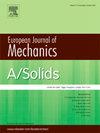Dynamic analysis and design optimization of hemispherical dielectric elastomer generator for efficient energy harvesting
IF 4.2
2区 工程技术
Q1 MECHANICS
引用次数: 0
Abstract
Dielectric elastomer energy generators (DEG), serving as efficient vibration energy harvesters, hold great potential in energy reuse and environmental energy exploitation. This study proposes a hemispherical DEG that employs pre-stretching and out-of-plane expansion deformation mode to achieve high-efficiency energy harvesting. For the proposed DEG, considering the viscoelasticity and electrostriction of DE materials, the study establishes a dynamic model of the hemispherical DEG based on the fractional viscoelastic model and the deformation-dependent electrostriction model. The model is then verified through experiments. Moreover, the influence of excitation parameters and structural parameters on the dynamic response of the proposed system is systematically investigated to better select the appropriate range of design parameters. Based on the established theoretical foundation, this paper leverages deep neural networks (DNN) combined with genetic algorithms (GA) to circumvent the complex dynamic solving process, and establishes a mapping relationship between multiple parameters and the energy output of the hemispherical DEG and seeks design solutions that maximize output power under different energy harvesting environmental conditions. This work provides new insights into the design and modeling of high-performance DEGs, which aids in the design and optimization of DEGs in low-frequency vibration environments.
半球形介质弹性体高效能量收集发生器的动态分析与优化设计
介电弹性体能量发生器作为一种高效的振动能量收集器,在能源再利用和环境能源开发方面具有巨大的潜力。本研究提出了一种采用预拉伸和面外膨胀变形模式的半球形DEG,以实现高效的能量收集。对于所提出的DEG,考虑DEG材料的粘弹性和电致伸缩,建立了基于分数粘弹性模型和变形相关电致伸缩模型的半球形DEG动力学模型。通过实验对模型进行了验证。此外,系统地研究了激励参数和结构参数对系统动态响应的影响,以便更好地选择合适的设计参数范围。在已建立的理论基础上,利用深度神经网络(DNN)结合遗传算法(GA)规避复杂的动态求解过程,建立多个参数与半球形DEG能量输出之间的映射关系,寻求不同能量采集环境条件下输出功率最大化的设计解。这项工作为高性能气体减速器的设计和建模提供了新的见解,有助于在低频振动环境下气体减速器的设计和优化。
本文章由计算机程序翻译,如有差异,请以英文原文为准。
求助全文
约1分钟内获得全文
求助全文
来源期刊
CiteScore
7.00
自引率
7.30%
发文量
275
审稿时长
48 days
期刊介绍:
The European Journal of Mechanics endash; A/Solids continues to publish articles in English in all areas of Solid Mechanics from the physical and mathematical basis to materials engineering, technological applications and methods of modern computational mechanics, both pure and applied research.

 求助内容:
求助内容: 应助结果提醒方式:
应助结果提醒方式:


